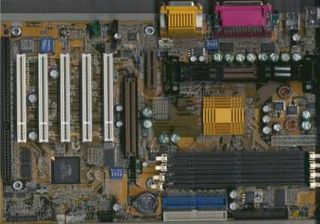21 Slot-1 Motherboards using VIA Chipsets
Gigabyte GA-6VX-4X
Board Revision: 1.1
BIOS Version: F4 (February 21, 2000)

Gigabyte's board uses the 694X chipset and makes use both of AC97 sound and of two additional USB ports. It comes with AGP 4x, , UltraDMA/66, four DIMM sockets and five PCI slots. One ISA slot has been left for older expansion cards. This board does have the AMR, but only a few BIOS settings to exert some influence on performance. For example, there's a general setting called "top performance" which worked fine under Windows 98, but provoked blue screens in Windows NT. I would have liked to know about the settings, which are changed by "top performance".
Maybe you've already seen this plastic part around the AGP slot. This is a card lock to prevent the AGP card from loosening, for example during system shipment. Two DIPswitch blocks are situated on the board: One for the multiplier and the other for the FSB setting. Here you can set 66, 100, 112, 124, 133, 142 or 152 MHz, which can be seen as "basic repertoire" for overclocking.
Gigabyte provides a DIMM LED and three fan headers to ensure proper cooling options. CPU locks have been installed, but also seem to be meant for one-way use. As with the FIC board, getting the processor out of the slot is quite an affair. Taking a look at the board's design, it seems to be quite good except for the audio line-in connectors, which are widely placed. The same applies to the second USB connector, which is situated on the wrong side of the board, unless you want to place the two additional USB ports somewhere at the computers front side.
The best feature of the 6VX-4X is Gigabyte's DualBIOS: If the first BIOS got damaged while flashing or due to a virus, you may switch to the second one and get your system working without time loss. The ECC support does contribute to reliability as well. 1.5 GByte SDRAM can be installed but be careful: The chipset only supports six memory banks. This means a maximum of three double-sided DIMMs or two double and two single sided.
Gigabyte's manual is easy to understand and almost complete. It is just missing some words and pictures about CPU installation. Finally, performance is a very important topic. Regarding Windows NT, the Gigabyte is the second fastest after the Asus. I believe that the board could still be somewhat faster, since I had to disable the "top performance" BIOS setting for NT benchmarking due to instabilities. Game performance is excellent as well, while the board gets third place in Windows 98.
Stay on the Cutting Edge
Join the experts who read Tom's Hardware for the inside track on enthusiast PC tech news — and have for over 25 years. We'll send breaking news and in-depth reviews of CPUs, GPUs, AI, maker hardware and more straight to your inbox.
Most Popular

